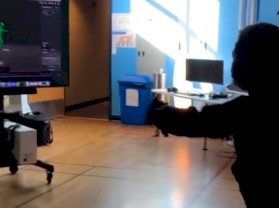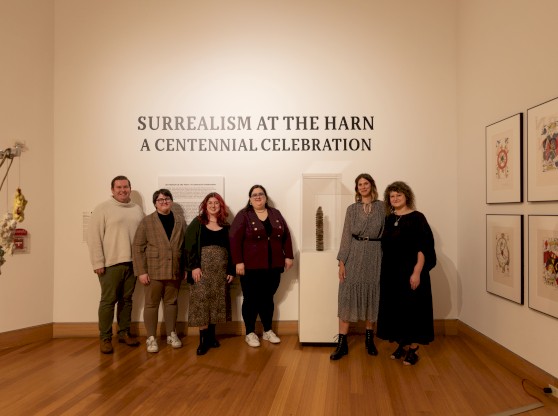When Eugene Ofori Agyei (MFA, ‘23) immigrated to the U.S. from Ghana in 2020 to pursue his MFA in ceramics at the University of Florida College of the Arts, he arrived at a lonely time to be a newcomer on campus—let alone, a 15-hour transatlantic flight away from home.
“I moved here during the pandemic. I don't have family here, so I spent my first Christmas holiday alone in my room,” Agyei recalls.
But Agyei is not one to sit idle. Not when he has clay to mold and a career to build. So, he outlined a plan to be seen and known in his new country of residence. His objectives: get into a residency every summer; show in an exhibition every month.
“I started thinking about how to stand out. I used that time as an opportunity to do research; to discover myself and what I was going to do with the materials I wanted to use in my work,” Agyei says.
In 2021, Agyei participated in more than a dozen shows. He joined fellow COTA artist, Emmanuel Manu Opoku (MFA, ‘21) in The Medium Is the Message: The African Diaspora Story, a traveling group exhibition featuring Ghanian artists working throughout the U.S. that premiered in Newark, Delaware in Nov., 2021.
In April, the Morean Arts Center named Agyei one of its Fresh Squeezed 6: Emerging Artists in Florida. In May, Agyei won the Pathways 2022: Carlos Malamud Prize presented by UCF Art Gallery, Rollins Museum of Art, and the Pabst-Steinmetz Foundation; accompanied by a $10,000 award and solo show in 2023.
In June, with works concurrently showing in the Morean, UCF Art Gallery, Rollins Museum, and at the Florida Mining Gallery, Agyei attended a workshop at the Haystack Mountain School of Crafts in Maine on a 2022 Artaxis Fellowship, and participated in a summer exhibition at Saratoga Clay Arts Center in upstate New York. This fall, Agyei is teaching at UF while preparing for his MFA show; a handful of additional exhibitions lined up along the way.
He has upcoming shows in 2022-23 at Delaware State University, Art & History Museums in Maitland, Florida, Art Center Sarasota, and the Rollins Museum of Art.
Agyei’s hands are rarely idle: molding clay, cutting and arranging fabrics, and braiding yarns. He keeps one eye focused on the future as the other holds Ghana in its gaze. All the while, he is cognizant of the distance that his fabrics, yarns, and hands have traveled. He works the clay to map the story of their journey.
Crafting clay to reveal the nuances of identity
Agyei received his Bachelor’s in Industrial Art in 2018 from the Kwame Nkrumah University of Science and Technology. High school in Ghana provided him with a strong graphic design background, but prior to college, Agyei had never worked with clay.
His curiosity piqued when he saw ceramicists tossing clay to “make something out of nothing,” and he gravitated to the medium in his first-year industrial art classes.
“The clay communicated to me from my first time working with it. It was a way to find myself and what I want to do as an artist,” Agyei says.
Although his mother encouraged him to pursue a traditional “breadwinner” career in STEM, Agyei was hooked on ceramics. He decided that earning an MFA in the U.S. would be his next step toward a professional art career. His destination: the University of Florida College of the Arts.
“I really started asking: ‘who am I as an artist? Who am I as a person living in a different country?’ The most prominent theme of my work is the idea of hybrid identity,” Agyei says.
Agyei is meticulous in his investigations of migration—his own, and that of his materials—and in crafting the stories of transnational hybridity in his work: a sculptural fusion of vibrant colors and textures that reveal and reflect on identity, cultural origins, and borders crossed.
“Ceramics have so many ways to produce so many outcomes—hand-building, throwing, coiling techniques, pinching techniques… I start by using coiling and slab-building. Once I’m doing that, I think about my audience because I always want to create a balanced narrative. Though my work talks about myself—I also want my viewer to have their own meaning in it,” Agyei says.
“Art is playful for me. My work process is usually done intuitively. I make sketches as an idea of what I want to do, but at the end of the day, I often get a different form—because once I’m making the work and thinking about my audience, I get different ideas about how to balance that narrative.”
After the clay is formed and fired, Agyei applies fabrics and yarn,
“I apply the fabric in a collage-like manner to give my work a visual language. I cut my fabrics to flow with a pattern, which is also a way of revealing my identity. And finally, I braid [the yarns] in my work as a way of blending both cultures. I perforate holes in the sculptures that aid with the flow of the yarn,” Agyei says.
Mixed media carries migratory stories
“I remember when I moved to the U.S., a friend of mine asked me, ‘Eugene, where are your tools?’ and I showed her my hands. In Ghana, you need to dig the clay from the site as raw material. You process your own clay—so, you find yourself into the material from the beginning until the end. In my studio in Gainesville, everything is already available. I reflect on the process in my work,” Agyei says.
Whereas the clay seems almost too easy to source in the U.S., textiles proved more complex.
“I grew up calling the fabric I work with ‘African fabric.’ But when I moved to the U.S. and started looking into materials that have what's called a ‘cultural background’—the history of the material—I realized there are questions about authenticity. Is it really from Africa? Is it really an African fabric?” Agyei says.
Agyei also discovered that most yarns available in the U.S. originate elsewhere.
“Yarns have miles. They travel. When they cross borders, they can take on different meanings. All these materials contribute to the idea of cultural hybridity in my work,” Agyei says.
Going straight to the source: a helping hand from home
While Agyei’s mom wasn’t initially sold on his plan to pursue an arts career, now, he says: “she's a big fan. She's on Instagram because of me; she's keeping up with my research—and she's an important part of the process in my work.”
Agyei emphasizes that using fabric with authentic African origins is paramount in his work.
“I ship my work fabric from Africa every summer. I make sure I ship as many fabrics as I can from Ghana—and this is done with the help of my mom,” Agyei says.
“We begin with a series of video calls, and we talk about the type of fabric that I want to use. When she goes to the market, we do another video call and she points and tells me, ‘this is the name of this fabric,’ and ‘this is fake,’ or ‘this is original.’”
With her eye for authenticity, Agyei’s mom helps him choose fabrics. Next, she heads to the post office and the fabrics begin their journey to Gainesville, Florida.
“When the fabric crosses the border, it goes through [similar] processes—immigration policies. So, when the cloth gets to my studio, I transform my own identity through the process of cutting and shredding the fabric to glue to the surface of my sculptures,” Agyei says.
Charting the next phase of the artist’s journey
“Coming to the U.S., and particularly coming to UF, has really helped me with my professional practices. Aside from teaching conceptual ideas in the studio, [UF instructors] also help you learn to become a professional artist—how to get into shows and residencies,” Agyei says.
He cites Professor Emeritus Anna Calluori Holcombe and Assistant Professor Jesse Ring as key influences in his professional success. He also notes Derek Reeverts and other UF faculty with whom he has participated in class and studio visits.
“When I first moved here, Anna said ‘you don't have to wait until you’re out of school before you get into shows. You need to get into shows and residencies while you are pursuing your MFA. You need to let people know who you are.’ She would guide me and always send opportunities on the listserv,” Agyei says.
“That gave me the confidence to believe in my work—to just try to put it out there. Sometimes I get rejection, but I deal with those rejections because I know that if one person doesn’t like my work—someone else will.”
Agyei teaches a ceramics class for non-ceramics majors at the School of Art + Art History.
“I really love it because they come in with no knowledge about clay and at the end of the semester, they get something from me to become creative—to make something out of nothing. It reminds me of how I started,” Agyei says.
“Teaching them has helped me in my creative practice because I learn from the students, as well. They all have a unique way of making their sculptures; of making their art. At the end of the day, I go back to my studio and I apply what I learned from them. We learn from each other—and that’s what I love about my class.”
Upon completing his MFA next fall, Agyei plans to continue exploring new media and exhibiting his work in as many corners of the globe as he can reach.
“Whenever I’m done with an artist talk, I end it by telling the audience that, you know, you have to make work. My philosophy is: not just to make work, but to make people really see the work you’re making,” Agyei says.
“My dream is to become a ceramics professor. I want to go back to Ghana to impart to my people what I’ve learned from the U.S.—but I have [other] dreams. Right now, my goal is to travel; to keep showing my way around the world.”
Artist website: EugeneAgyeiArts.com
Follow Eugene on Instagram for his latest news.





